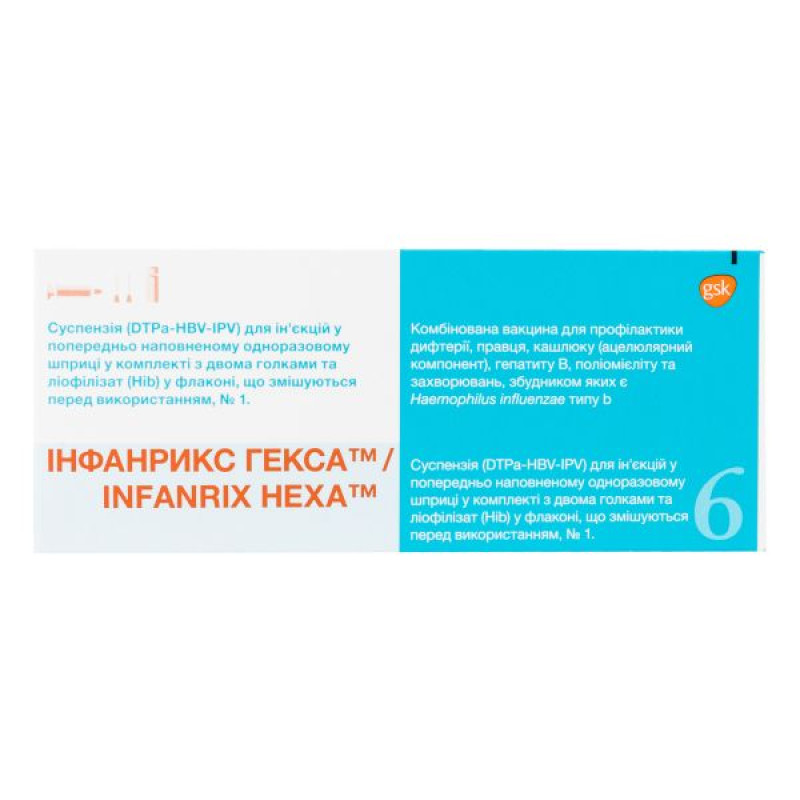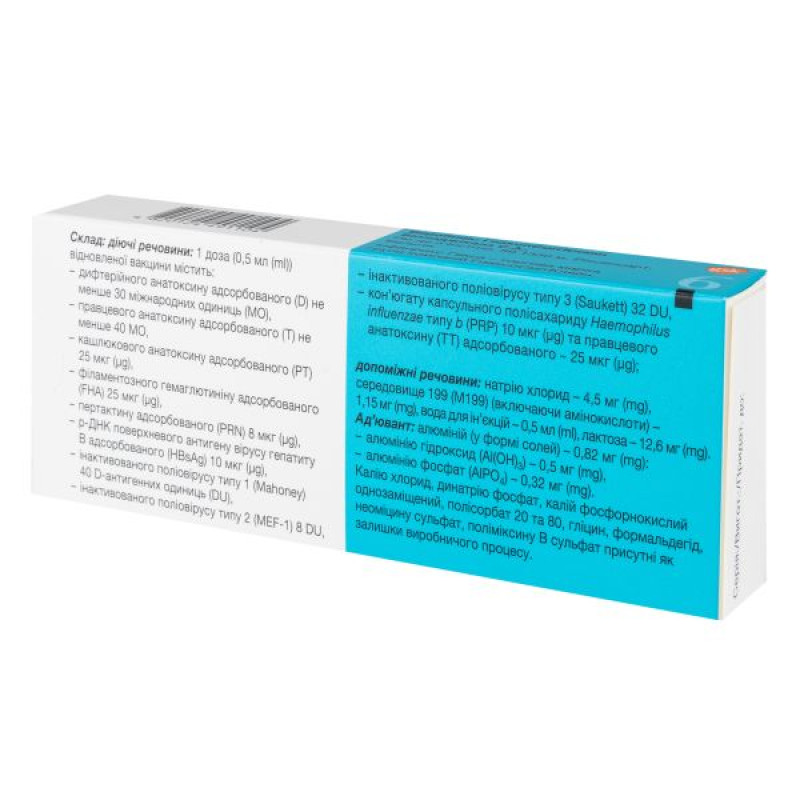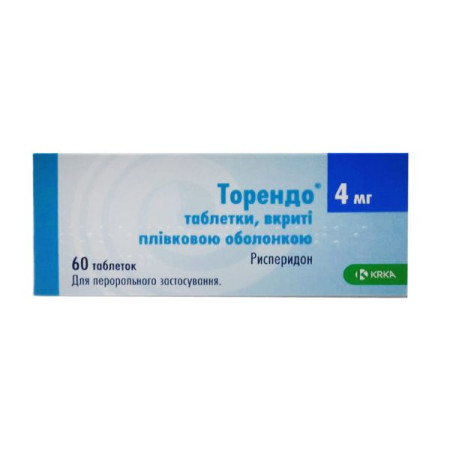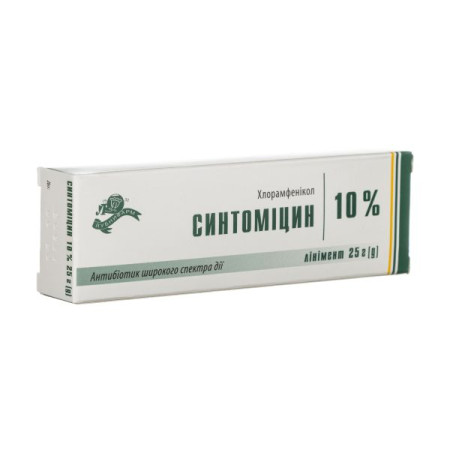Infanrix hexa suspension for injection, disposable syringe + lyophilized powder for injection in vial No. 1
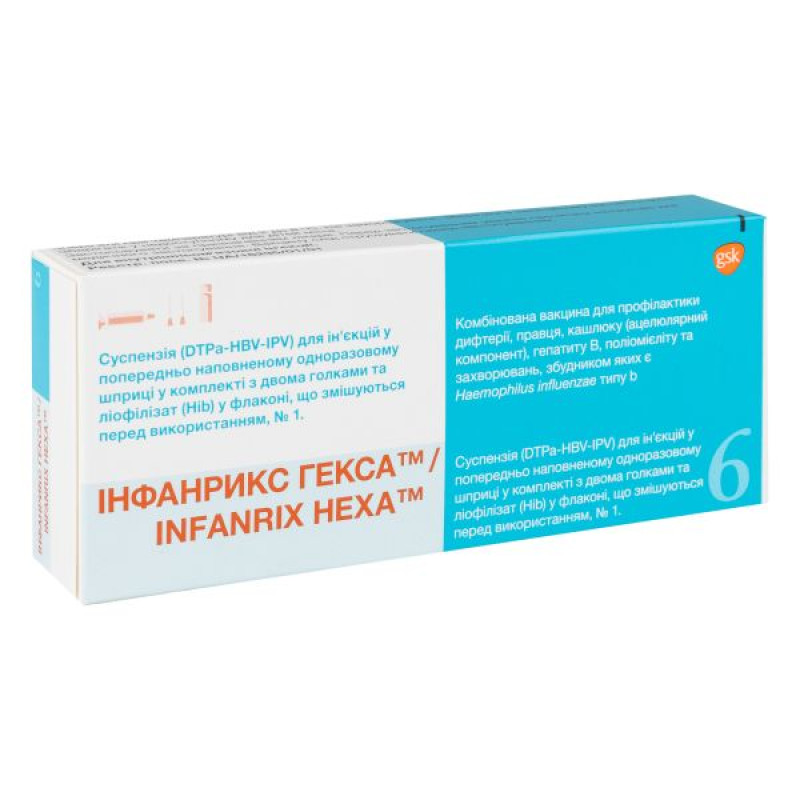
Instructions for use Infanrix hexa suspension for injection, disposable syringe + lyophilized powder for injection in vial No. 1
Warehouse
Active ingredients: 1 dose (0.5 ml) of reconstituted vaccine contains:
| diphtheria toxoid (D)1 | - ≥ 30 IU or 25 Lf; |
| tetanus toxoid (T)1 | - ≥ 40 IU or 10 Lf; |
| Bordetella pertussis pertussis antigens: | |
| pertussis toxoid (PT)1 | - 25 mcg; |
| filamentous hemagglutinin (FHA)1 | - 25 mcg; |
| pertactin (PRN)1 | - 8 mcg; |
| p-DNA hepatitis B virus surface antigen (HBsAg)2,3 | - 10 mcg; |
| inactivated polio viruses: | |
| type 1 (Mahoney strain)4 | - 40 D-antigen units; |
| type 2 (strain MEF-1)4 | - 8 D-antigen units; |
| type 3 (Saukett strain)4 | - 32 D-antigen units. |
| Haemophilus influenzae type b polysaccharide (polyribosylribitol phosphate, PRP)3 conjugated with tetanus toxoid (TT) as a protein carrier | - 10 mcg; 25 mcg; |
1 adsorbed on aluminum hydroxide, hydrated (Al(OH)3) 2 produced in yeast cells (Saccharomyces cerevisiae) using r-DNA technology 3adsorbed on aluminum phosphate (AlPO4) | 0.5 mg Al3+ 0.32 mg Al3 |
| 4 propagated on Vero cells | |
Excipients: sodium chloride, medium 199, water for injection, lactose, aluminum salts.
Potassium chloride, disodium phosphate, monosodium phosphate, polysorbate 20 and 80, glycine, formaldehyde, neomycin sulfate, polymyxin B sulfate are present as residues from the manufacturing process.
Dosage form
Suspension (DTPa-HBV-IPV) for injection and lyophilisate (Hib) mixed before use.
Main physicochemical properties: INFANRIX HEXA™ is a combined vaccine for the prevention of diphtheria, tetanus, pertussis (acellular component), hepatitis B, poliomyelitis and diseases caused by Haemophilus influenzae type b.
INFANRIX HEXA™ meets the requirements of the World Health Organization for the production of biological substances, diphtheria, tetanus, pertussis and combined vaccines, vaccines for the prevention of hepatitis B obtained using recombinant DNA technology, inactivated vaccines for the prevention of poliomyelitis and conjugated Hib vaccines.
Pharmacotherapeutic group
Bacterial and viral vaccines are combined.
ATX code J07C A09.
Pharmacological properties
Pharmacodynamics
Immunogenicity
The immunogenicity of INFANRIX HEXA™ has been evaluated in clinical studies in children from 6 weeks of age. The vaccine was evaluated in 2-dose and 3-dose primary vaccination schedules, including the Expanded Programme on Immunization, and as a booster dose. The results of these clinical studies are summarized in the tables below.
After the 3-dose primary vaccination schedule, at least 95.7% of infants developed seroprotective or seropositive levels of antibodies against each antigen included in the vaccine. After booster vaccination (after dose 4), at least 98.4% of children developed seroprotective or seropositive levels of antibodies against each vaccine antigen.
Table 1
Percentage of subjects with antibody titers ≥ assay cutoff, one month after 3-dose primary and booster vaccination with INFANRIX HEXA™ vaccine
Antibody (limit value) | After dose 3 | After dose 4 (booster vaccination in the second year of life after a 3-dose primary course) | |||
2-3-4 months N=196 (2 experiments) (requirement) | 2-4-6 months N=1693 (6 studies) | 3-4-5 months N=1055 (6 studies) | 6-10-14 weeks N=265 (1 study) | N=2009 (12 studies) | |
| % | % | % | % | % | |
Antidiphtheria (0.1 IU/mL) † | 100.0 | 99.8 | 99.7 | 99.2 | 99.9 |
Antitetanus (0.1 IU/mL) † | 100.0 | 100.0 | 100.0 | 99.6 | 99.9 |
Anti-PT (5 U ITA/ml) | 100.0 | 100.0 | 99.8 | 99.6 | 99.9 |
Anti-FHA (5 U ITA/ml) | 100.0 | 100.0 | 100.0 | 100.0 | 99.9 |
Anti-PRN (5 U ITA/ml) | 100.0 | 100.0 | 99.7 | 98.9 | 99.5 |
Anti-HBs (10 mIU/mL) † | 99.5 | 98.9 | 98.0 | 98.5* | 98.4 |
Against polio type 1 (dilution 1/8) † | 100.0 | 99.9 | 99.7 | 99.6 | 99.9 |
Against polio type 2 (dilution 1/8) † | 97.8 | 99.3 | 98.9 | 95.7 | 99.9 |
Against polio type 3 (dilution 1/8) † | 100.0 | 99.7 | 99.7 | 99.6 | 99.9 |
Anti-PRP (0.15 mcg/mL) † | 96.4 | 96.6 | 96.8 | 97.4 | 99.7 |
N - number of people;
* in the subgroup of newborns who were not vaccinated against hepatitis B at birth, 77.7% of individuals had anti-HBs titers ≥10 mIU/ml;
After complete vaccination according to the 2-dose primary vaccination schedule and booster vaccination with INFANRIX HEXA™ vaccine, at least 97.9% of individuals developed seroprotective or seropositive levels of antibodies against each antigen included in the vaccine.
Table 2
Percentage of subjects with antibody titers ≥ assay cutoff, following a 2-dose primary and booster vaccination regimen with INFANRIX HEXA™ vaccine
Antibody (limit value) | After dose 3 (vaccination at the age of 2-4-12 months) N=196 (1 study) | After dose 3 (vaccination at the age of 3-5-11 months) N=532 (3 studies) |
| % | % | |
| Antidiphtheria (0.1 IU/mL) † | 100.0 | 100.0 |
| Antitetanus (0.1 IU/mL) † | 100.0 | 100.0 |
| Anti-PT (5 ITA units/ml) | 99.5 | 100.0 |
| Anti-FHA (5 ITA units/ml) | 100.0 | 100.0 |
| Anti-PRN (5 ITA units/ml) | 100.0 | 99.2 |
| Anti-HBs (10 mIU/mL) † | 99.8 | 98.9 |
Against polio type 1 (dilution 1/8) † | 98.4 | 99.8 |
Against polio type 2 (dilution 1/8) † | 98.4 | 99.4 |
Against polio type 3 (dilution 1/8) † | 97.9 | 99.2 |
| Anti-PRP (0.15 mcg/mL) † | 100.0 | 99.6 |
N - number of people;
† limit value accepted as an indicator of protection.
Serological protection ratios have been established for diphtheria, tetanus, poliomyelitis, hepatitis B and Hib. There is no serological protection ratio for pertussis. However, as the immune response to pertussis antigens in INFANRIX HEXA™ is equivalent to that in INFANRIX™, the protective efficacy of the two vaccines is expected to be similar.
Protective efficacy against whooping cough
The protective efficacy of INFANRIX™ for the prevention of typical pertussis as defined by WHO (≥ 21 days of paroxysmal cough) was demonstrated after a primary immunization with three doses in the clinical studies listed in Table 3.
Table 3
| Clinical study | Country | Immunization schedule | Vaccine effectiveness | Factors |
| Family contact study (blind prospective) | Germany | 3, 4, 5 months | 88.7% | Based on data collected from secondary contacts in families in which an index case of typical pertussis was observed. |
| Effectiveness study (sponsored by the National Institutes of Health) | Italy | 2, 4, 6 months | 84% | In a follow-up of the same group of patients, vaccine efficacy was confirmed for 60 months after completion of primary vaccination without a booster dose of pertussis vaccine. |
The immunogenicity of INFANRIX HEXA™ in infants and young children born to healthy mothers who were vaccinated with AaKDP-M vaccine at 27-36 weeks of gestation was evaluated in two clinical studies. INFANRIX HEXA™ was administered concomitantly with 13-valent pneumococcal conjugate vaccine to infants at 2, 4 and 6 months or at 2, 3 and 4 months according to a three-dose primary vaccination schedule (n = 241) or at 3 and 5 months or at 2 and 4 months according to a two-dose primary vaccination schedule (n = 27); and was also administered to infants/children aged 11 to 18 months as a booster dose (n = 229).
Immunological data after primary and booster vaccination did not show a clinically significant effect of maternal vaccination with AaKDP-M vaccine on the responses of infants and young children after vaccination with INFANRIX HEXA™ vaccine and pneumococcal vaccine.
Lower antibody concentrations against pertussis antigens after primary vaccination (PT, FHA, and PRN) and after booster vaccination (PT, FHA) were observed in infants and young children whose mothers were vaccinated with AaKDP-M vaccine during pregnancy. The increase in pertussis antibody concentrations before the start of booster vaccination and 1 month after booster vaccination was in the same range for infants and young children whose mothers were vaccinated with AaKDP-M vaccine or placebo, demonstrating the effectiveness of primary vaccination. In the absence of correlates of protection against pertussis, the clinical significance of these observations remains unclear. However, current epidemiological data on pertussis disease after maternal immunization with AaKDP-M vaccine do not suggest any clinical significance of this immune intervention.
Immunogenicity in premature infants
The immunogenicity of INFANRIX HEXA™ was evaluated in three clinical studies after completion of a 3-dose primary vaccination course (2-4-6 months) involving approximately 300 preterm infants (gestational age 24-36 weeks). The immunogenicity of the vaccine after a booster dose at 18-24 months of age was evaluated in approximately 200 preterm infants.
One month after booster vaccination, at least 98.4% of subjects had seroprotective or seropositive antibody levels against each antigen, except for antibodies against PT (at least 96.8%) and hepatitis B (at least 88.7%). The response to booster vaccination in terms of fold increase in antibody levels (15-235-fold) indicates that the primary vaccine complex was adequate for all antigens of INFANRIX HEXA™ vaccine for preterm infants.
In a prospective study, approximately 2.5-3 years after booster vaccination, 85.3% of children still had seroprotective levels of antibodies against hepatitis B and at least 95.7% had seroprotective levels of antibodies against the three types of poliovirus and PRP.
Duration of immune response
The duration of the immune response after completion of a 3-dose primary vaccination course and a booster dose of INFANRIX HEXA™ was evaluated in children aged 4 to 8 years. Protective immunity against the three types of poliovirus and PRP was observed in at least 91.0% of children, and against diphtheria and tetanus in at least 64.7% of children. At least 25.4% (anti-PT), 97.5% (anti-FHA) and 87.0% (anti-PRN) of children were seropositive against the pertussis component antigens.
For hepatitis B, seroprotective antibodies were demonstrated in ≥ 85% of children aged 4-5 years, ≥ 72% of children aged 7-8 years, ≥ 60% of children aged 12-13 years and 53.7% of children aged 14-15 years after a 3-dose primary and booster vaccination course with INFANRIX HEXA™. In addition, seroprotective levels of antibodies against HBV were maintained in ≥ 48% of children aged 11-12 years after a 2-dose primary and booster vaccination course.
Immunological memory against HBV has been confirmed in children aged 4-15 years. These children received INFANRIX HEXA™ as a primary vaccination and a booster vaccination in the neonatal period, and after an additional dose of monovalent HBV vaccine, immune protection was observed in at least 93% of individuals
Post-registration experience
Long-term follow-up in Sweden shows that acellular pertussis vaccine is effective in infants when given as a primary vaccination course at 3 and 5 months and a booster dose at approximately 12 months of age. However, there is evidence that protection against pertussis wanes in children aged 7-8 years with the 3-5-12 month vaccination schedule. Therefore, a second booster dose of vaccine may be warranted in children aged 5-7 years who have previously been vaccinated with this schedule.
The efficacy of the Hib component of INFANRIX HEXA™ has been established and continues to be studied in a clinical study in Germany during the post-marketing surveillance period. During the 7-year follow-up period, the efficacy of the Hib components of the two hexavalent vaccines, one of which was INFANRIX HEXA™, was found to be 89.6% for vaccinees who received the primary vaccine series and 100% for vaccinees who received the primary vaccine series plus a booster dose (regardless of the Hib vaccine used for the primary vaccination).
INFANRIX HEXA™ has been the main Hib-containing vaccine in Italy, available since 2006. Immunization is carried out at 3, 5 and 11 months of age, with vaccination coverage exceeding 95%. The country continues to have good control of Hib infection: from 2006 to 2011, no more than 3 confirmed cases of Haemophilus influenzae type b infection were detected annually in Italy among children under 5 years of age.
Pharmacokinetics
Assessment of pharmacokinetic properties is not mandatory for vaccines.
Indication
INFANRIX HEXA™ vaccine is indicated for primary and booster immunization of children for the prevention of diphtheria, tetanus, pertussis, hepatitis B, poliomyelitis and diseases caused by Haemophilus influenzae type b.
Contraindication
INFANRIX HEXA™ vaccine is not prescribed to individuals with hypersensitivity to the main components or to any of the excipients/residues, including polymyxin, neomycin and formaldehyde (see section "Composition") and to individuals who have shown signs of hypersensitivity after previous administration of vaccines for the prevention of diphtheria, tetanus, pertussis, hepatitis B, poliomyelitis or diseases caused by Haemophilus influenzae type b (Hib).
INFANRIX HEXA™ is contraindicated in children who have experienced encephalopathy of unknown etiology within 7 days of previous vaccination with a pertussis-containing vaccine. In these circumstances, pertussis vaccination should be discontinued and the vaccination course should be continued with vaccines for the prevention of diphtheria, tetanus, hepatitis B, inactivated poliomyelitis vaccine and vaccine for the prevention of diseases caused by the pathogen Haemophilus influenzae type b.
As with other vaccines, the administration of INFANRIX HEXA™ should be postponed in patients with an acute illness accompanied by fever. The presence of a minor infection is not a contraindication.
Interaction with other medicinal products and other types of interactions
INFANRIX HEXA™ can be administered concomitantly with pneumococcal conjugate vaccines, meningococcal C conjugate vaccine (MenC), meningococcal A, C, W, Y conjugate vaccine (MenACWY), meningococcal B conjugate vaccine (MenB), rotavirus, measles, mumps, rubella and varicella vaccines. Data do not indicate a clinically relevant effect on the antibody response to each of the individual antigens.
Clinical trial data indicate that the incidence of febrile reactions is higher when INFANRIX HEXA™ is administered concomitantly with pneumococcal conjugate vaccine than when INFANRIX HEXA™ is administered alone. Data from one clinical trial indicate that the incidence of febrile reactions is higher when INFANRIX HEXA™ is administered concomitantly with measles, mumps, rubella and varicella vaccine than when INFANRIX HEXA™ is administered alone, and is similar to that of measles, mumps, rubella and varicella vaccine alone (see sections 4.4 and 4.8). There was no effect on the immune response.
Due to the increased risk of fever, injection site pain, loss of appetite and irritability when INFANRIX HEXA™ is administered concomitantly with meningococcal B (MenB) and 7-valent pneumococcal conjugate vaccines, it is advisable to consider separate vaccinations whenever possible.
If INFANRIX HEXA™ is used at the same time as other injectable vaccines, these drugs should always be administered at different sites of the body.
As with other vaccines, it can be expected that patients receiving immunosuppressive therapy may not achieve an adequate immune response.
Application features
Vaccination should be preceded by a medical history (especially regarding previous vaccination and possible cases of adverse reactions) and a clinical examination.
As with all vaccines, the immune system response may not reach a protective level in all vaccinees (see section “Immunological and biological features”).
INFANRIX HEXA™ will not prevent disease caused by pathogens other than Corynebacterium diphtheriae, Clostridium tetani, Bordetella pertussis, hepatitis B virus, poliovirus or Haemophilus influenzae type b. However, it can be expected that immunisation will prevent hepatitis D, as hepatitis D (which is caused by a delta virus) does not occur in the absence of hepatitis B infection.
If any of the following conditions are known to occur in temporal association with pertussis-containing vaccine, the decision to administer a subsequent dose of pertussis-containing vaccine should be carefully considered:
- temperature ≥ 40.0 °C within 48 hours after vaccination, not associated with other causes;
- collapse or shock-like state (hypotonic-hyporesponsive episode) within 48 hours after vaccination;
- continuous crying lasting ≥ 3 hours within 48 hours after vaccination;
- convulsions with or without fever occurring within 3 days after vaccination.
In conditions of high pertussis incidence, the potential benefit outweighs the possible risk.
Children with progressive neurological disorders, including infantile spasms, uncontrolled epilepsy, or progressive encephalopathy, should preferably delay pertussis vaccination (with acellular or whole-cell pertussis vaccine) until their condition improves or stabilizes. However, the decision to use pertussis vaccine should be made on an individual basis after careful consideration of the potential risks and benefits.
As with all injectable vaccines, appropriate medical treatment and supervision should always be readily available in case of rare anaphylactic reactions following the administration of the vaccine. Therefore, patients should be observed for at least 30 minutes after vaccination.
INFANRIX HEXA™ vaccine should be administered with caution to individuals with thrombocytopenia or blood clotting disorders, as bleeding is possible with intramuscular administration in such individuals.
Do not administer the vaccine intravascularly or intradermally.
A personal history of febrile seizures, a family history of seizures or sudden infant death syndrome is not a contraindication for vaccination with INFANRIX HEXA™. Vaccinated individuals with a history of febrile seizures should be monitored as such adverse events may occur 2-3 days after vaccination.
When INFANRIX HEXA™ is administered concomitantly with pneumococcal conjugate vaccine (PKV7, PKV10, PKV13) or with measles, mumps, rubella and varicella vaccine, the incidence of febrile reactions is higher than when INFANRIX HEXA™ is administered alone. In most cases, these reactions were mild (fever ≤ 39 °C) and resolved (see sections 4.8 and 4.5).
An increased frequency of reports of convulsions (with or without fever) and hypotonic-hyporesponsive episodes (HHE) has been observed with concomitant use of INFANRIX HEXA™ and PKV13 (see section 4.8).
Syncope (fainting) may occur during or before any injectable vaccination, as a psychogenic reaction to the needle injection. Vaccination should only be performed with the vaccinee in a sitting or lying position and should be maintained in the same position (sitting or lying) for 15 minutes after vaccination to prevent the risk of injury.
Special patient groups
Human immunodeficiency virus (HIV) infection is not considered a contraindication. Immunocompromised patients may not develop an adequate immunological response after vaccination.
Clinical data indicate that INFANRIX HEXA™ can be administered to premature infants; however, as expected for this group, a weaker immune response to some antigens was observed (see sections “Adverse reactions” and “Immunological and biological properties”).
When prescribing primary immunization to very preterm infants (≤ 28 weeks of gestation), the potential risk of apnoea and the need for respiratory monitoring for 48-72 hours after vaccination should be considered, especially if the infant has a history of respiratory failure. Since the benefit of vaccination is high for this group of infants, vaccination should not be withheld or delayed.
Impact on laboratory tests
Because the Hib capsular polysaccharide antigen is excreted in the urine, a positive urine test may be observed for up to 2 weeks after vaccination. Other tests should be performed to confirm Hib infection during this period.
This medicinal product contains less than 1 mmol (39 mg)/dose of potassium, i.e. essentially potassium-free.
This medicinal product contains less than 1 mmol (23 mg) sodium/dose, i.e. essentially sodium-free.
Use during pregnancy or breastfeeding
Since INFANRIX HEXA™ vaccine is not intended for use in adults, there are no data on the safety of the vaccine during pregnancy or lactation.
Ability to influence reaction speed when driving vehicles or other mechanisms
Does not apply to this group.
Method of administration and doses
Method of application
INFANRIX HEXA™ is intended for deep intramuscular injection. The body area should be rotated for subsequent injections.
Dosage
The primary vaccination schedule consists of two or three doses (0.5 ml each) to be administered according to official recommendations (see Table 4 and section “Immunological and biological properties” for information on vaccination schedules evaluated in clinical studies). INFANRIX HEXA™ may be considered for booster vaccination if the antigenic composition is in accordance with official country recommendations, but at least one dose of Hib conjugate vaccine is recommended.
| Primary vaccination | Booster vaccination | General provisions |
| Full-term newborns | ||
| 3 doses | Booster vaccination can be carried out. | There should be an interval of at least 1 month between doses of primary vaccination. · The booster dose should be administered at least 6 months after the last dose of primary vaccination and preferably before 18 months of age. |
| 2 doses | It is imperative to get a booster vaccination. | There should be an interval of at least 1 month between doses of primary vaccination. · The booster dose should be administered at least 6 months after the last dose of primary vaccination and preferably between 11 and 13 months after birth. |
| Premature infants (at least 24 weeks gestation) | ||
| 3 doses | It is imperative to get a booster vaccination. | There should be an interval of at least 1 month between doses of primary vaccination. · The booster dose should be administered at least 6 months after the last dose of primary vaccination and preferably before 18 months of age. |
The administration of INFANRIX HEXA™ vaccine, according to the Expanded Program on Immunization (at 6, 10, 14 weeks of age), can only be used if the vaccinee received a dose of hepatitis B vaccine at birth.
If the vaccinee received a dose of hepatitis B vaccine at birth, INFANRIX HEXA™ can be used as a substitute for additional doses of hepatitis B vaccine from the age of 6 weeks. If a second dose of hepatitis B vaccine is required before this age, a monovalent hepatitis B vaccine should be used.
Hepatitis B immunoprophylaxis measures established by the competent authorities of each country should be followed.
Vaccination of children in Ukraine is carried out in accordance with the requirements of the current orders of the Ministry of Health of Ukraine regarding preventive vaccinations.
Instructions for use of the vaccine
Any unused product or waste materials should be disposed of in accordance with the requirements of current regulations in Ukraine.
The vaccine should be prepared by adding the entire contents of the pre-filled syringe containing DTPa-HBV-IPV suspension to the vial containing Hib powder. The mixture should be shaken well until the powder is completely dissolved in the suspension.
It is good clinical practice to administer the vaccine only when it has reached room temperature. In addition, when the vial reaches room temperature, sufficient elasticity of the rubber stopper of the vial is ensured, which minimizes the entry of rubber particles into the vial. To achieve this, the vial should be left at room temperature (25 ± 3 °C) for at least five minutes before injecting the suspension from the syringe and reconstituting the vaccine.
The reconstituted vaccine is a slightly more cloudy suspension than the liquid component alone. This is normal.
The reconstituted vaccine should be inspected visually for any foreign particulate matter and/or variation of physical appearance. If any of the above are observed, the vaccine should not be used.
Any unused product or waste materials should be disposed of in accordance with the requirements of applicable regulations in Ukraine.
After reconstitution, the vaccine should be used immediately. However, the vaccine may be stored for up to 8 hours at room temperature (21°C).
Collect the entire contents of the vial.
Holding the syringe barrel in one hand (do not hold the syringe plunger), unscrew the syringe cap by turning it counterclockwise.
Insert the needle into the syringe, screw it all the way clockwise (see picture).
Remove the needle cap, which may be a little tight.
Reconstitute the vaccine as described above.
Children
There are no data on the safety and efficacy of INFANRIX HEXA™ in children aged 3 years and older (see sections “Indications”, “Method of administration and dosage”).
Overdose
There is not enough data.
Adverse reactions
Clinical trial data
The safety profile presented below is based on data obtained from immunization of more than 16,000 patients.
As with DTPa and DTPa-containing combination vaccines, an increased incidence of local reactions and fever has been reported following booster vaccination with INFANRIX HEXA™ compared to the primary course.
The reactions observed were determined with the following frequency:
very common: > 1/10
common: > 1/100 and < 1/10
uncommon: > 1/1000 and < 1/100
rare: > 1/10,000 and < 1/1,000
very rare: < 1/10,000
| Organ system class | Frequency | Adverse reactions |
| Infections and infestations | Infrequently | Upper respiratory tract infections |
| Rarely | Bronchitis | |
| Metabolic and nutritional disorders | Very often | Loss of appetite |
| Mental disorders | Very often | Irritability, constant crying, restlessness |
| Often | Nervousness | |
| Nervous system dysfunction | Very often | Drowsiness |
| Very rare | Convulsions (with and without fever)*** | |
| Respiratory, thoracic and mediastinal dysfunction | Infrequently | Cough* |
| Gastrointestinal disorders | Often | Vomiting, diarrhea |
| Skin and subcutaneous tissue dysfunction | Rarely | Rash |
| Often | Itch* | |
| Very rare | Dermatitis, urticaria* | |
| General disorders and administration site conditions | Very often | Pain, redness, local swelling at the injection site (≤ 50 mm), fever ≥ 38 °C. |
| Often | Local swelling at the injection site (>50 mm)**, fever >39.5°C, pathological reactions at the injection site, including induration. | |
| Infrequently | Diffuse swelling of the injected limb, sometimes extending to adjacent joints**, fatigue |
* Observed only with other GlaxoSmithKline vaccines containing DTPa.
**Children who received primary doses of acellular pertussis vaccine were more likely to experience swelling reactions after a booster dose compared to whole cell pertussis vaccine. These reactions resolved on average after 4 days.
*** Analysis of post-marketing reports indicates a potential increased risk of convulsions (with or without fever) and hypotonic-hyporesponsive episodes when INFANRIX HEXA™ is administered with pneumococcal polysaccharide conjugate vaccine adsorbed 13-valent (PKV13) compared to INFANRIX HEXA™ alone.
Post-marketing surveillance data
The following drug-related adverse reactions have been reported during post-marketing surveillance.
Table 6
| Organ system class | Adverse reactions |
| Disorders of the circulatory and lymphatic systems | Lymphadenopathy, thrombocytopenia |
| Immune disorders | Allergic reactions (including anaphylactic and anaphylactoid reactions) |
| Collapse or shock-like state (hypotonic-hyporesponsive episode)*** | |
| Respiratory system disorders | Apnea* (see section 4.4 for apnea in premature infants (≤ 28 weeks of gestation)) |
| Skin and subcutaneous tissue disorders | Angioedema* |
| Injection site reactions | Common reactions include swelling, swelling of the entire vaccinated limb**, and vesicles at the injection site. |
* Observed only with other GlaxoSmithKline vaccines containing DTPa.
**Children who received primary doses of acellular pertussis vaccine were more likely to experience swelling reactions after a booster dose compared to those who received whole cell pertussis vaccines. These reactions resolved on average after 4 days.
*** Analysis of post-marketing reports indicates a potential increased risk of convulsions (with or without fever) and hypotonic-hyporesponsive episodes when INFANRIX HEXA™ is administered with pneumococcal polysaccharide conjugate vaccine adsorbed 13-valent (PKV13) compared to INFANRIX HEXA™ alone.
Clinical experience with the use of INFANRIX HEXA™ vaccine concomitantly with PCV7
In clinical trials in which some vaccinees received INFANRIX HEXA™ concomitantly with pneumococcal polysaccharide conjugate vaccine 7-valent (PKV 7) as a booster (4th) dose of both vaccines, fever ≥ 38.0°C was reported in 43.4% of children receiving PKV 7 with INFANRIX HEXA™ compared to 30.5% of children vaccinated with INFANRIX HEXA™ alone. Fever ≥ 39.5°C was observed in 2.6% and 1.5% of children receiving INFANRIX HEXA™ with or without PKV 7, respectively (see sections 4.4 and 4.5). The incidence of fever following simultaneous administration of two vaccines during the primary vaccination course was lower than that observed after booster vaccination.
Clinical experience of using INFANRIX HEXA™ vaccine simultaneously with measles, mumps, rubella and varicella vaccines.
In a clinical study in which some vaccinees received a booster dose of INFANRIX HEXA™ at the same time as measles, mumps, rubella and varicella vaccine, fever ≥ 38.0°C was observed in 76.6% of children, compared with 48% among children vaccinated with INFANRIX HEXA™ alone and 74.7% among children vaccinated with measles, mumps, rubella and varicella vaccine alone. Fever above 39.5°C was observed in 18% of children vaccinated with INFANRIX HEXA™ concomitantly with measles, mumps, rubella and varicella vaccine, compared with 3.3% among children vaccinated with INFANRIX HEXA™ alone and 19.3% among children vaccinated with measles, mumps, rubella and varicella vaccine alone (see sections 4.4 and 4.5).
Safety of vaccine use in premature infants
INFANRIX HEXA™ has been administered to over 1000 preterm infants (gestational age 24-36 weeks) in primary vaccination studies and to over 200 preterm infants as a booster dose in the second year of life. In comparative studies, similar rates of adverse reactions were observed in preterm and full-term neonates.
There are no reviews for this product.
There are no reviews for this product, be the first to leave your review.
No questions about this product, be the first and ask your question.







